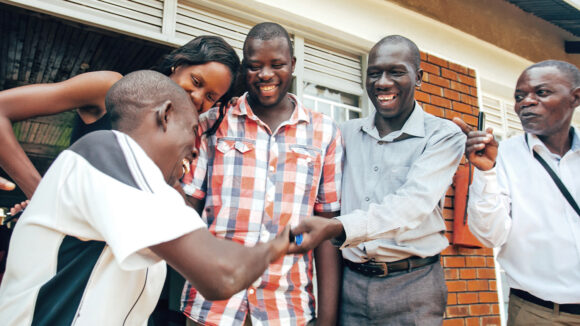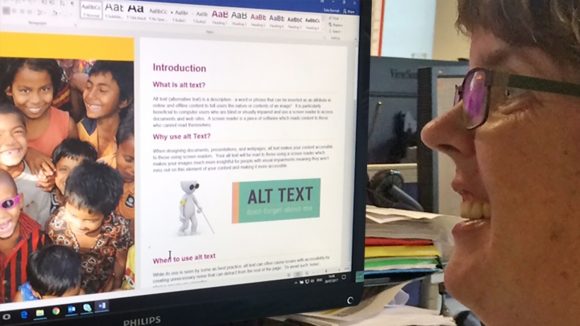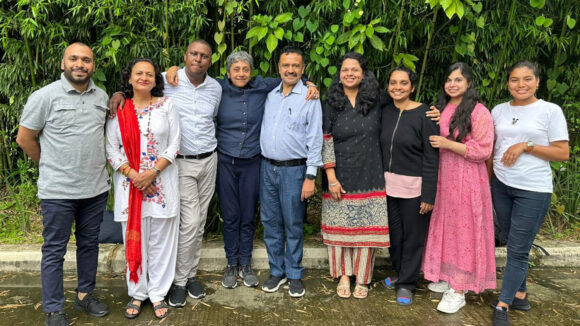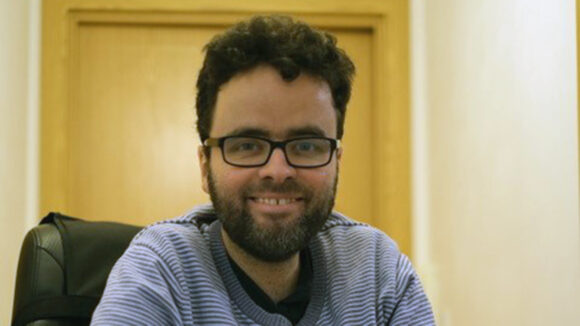How can we include people with intellectual disabilities at work?
People with intellectual disabilities are among the most excluded groups of people in society.
In many circumstances, they’re not listened to and have no say in the decisions that affect them. This is due to several reasons including stigmatising policies and practices, assumptions about what people with disabilities can or cannot do, and inaccessible environments and information. What’s more, individuals and organisations often don’t have the adequate knowledge, tools and support to promote the meaningful inclusion of people with intellectual disabilities.
As part of the Inclusion Works project funded by Inclusive Futures, Sightsavers recently formed a partnership with Inclusion International (II) and Down Syndrome International (DSI) to develop resources to support people with intellectual disabilities at work.
As part of the series of internal lunchtime seminars organised by our Disability Inclusion Working Group, we recently welcomed Ailis Hardy, Tia Ellis and Mark Mbemba from Inclusion International to deliver a talk about this project to Sightsavers staff.
Inclusion International’s mission statement is to create a world where people with intellectual disabilities and their families can take part and be valued equally in all areas of their lives, through global advocacy work, connecting members to share knowledge about building inclusion and supporting members working for inclusion in their countries.
During the session, we learned how they had brought together a reference group of members from II and DSI to give guidance as they worked on the project. They ran a survey to hear from members about the barriers to inclusion and good practices that work best to make sure people with intellectual disabilities are included.
The survey was translated into 10 languages, along with easy-read versions. By doing this, they gained contributions from 350 organisations and more than 1,500 people from 100 countries. The results showed that the main barriers to inclusion in the workplace were:
- Lack of awareness and understanding of intellectual disabilities, which can lead to discrimination stereotyping, segregation and exclusion
- Inaccessible information and communication
- Not providing reasonable accommodations or workplace adjustments
- Poor support from the people around them (help may be needed to understand information, learn new skills or tasks and/or make decisions)
- Lack of time to understand and do their work
- Exclusion from decision-making – for example, leadership roles and staff teams – meaning they have no voice
- A struggle with additional costs for individuals because organisations do not budget for the costs of inclusion
As a result, the Listen, Include, Respect guidelines were developed to help overcome the barriers that prevent people with intellectual disabilities from taking part in employment. They cover topics ranging from communication and information to meetings and consultations, to employing people and leadership. The guidelines are clear and easy to read, and a recommended resource for anyone seeking to embed inclusion in their organisation.
For example, the email communication guidelines include the following tips:
- Always write in plain language. Use a large font size and avoid abbreviations and jargon
- Don’t use short-hand or acronyms – they don’t make sense when read by a screen reader
- Summarise lengthy discussions when forwarding a chain of emails, to help everyone understand the background of the conversation
- Use headings to break up long emails and signpost important information
- Make the subject line of the email clear and relevant
- Use a clear, black sans serif font and avoid italics
- Use lists to break information into small, manageable chunks
Personally, it was interesting to observe that similar barriers are often mentioned when we deliver our internal disability awareness training to staff. Most of these barriers affect people with disabilities in general, although they can be even more severe and more difficult to overcome for people with intellectual disabilities.
Inclusion at Sightsavers
The talk was both interesting and thought-provoking. We were asked to consider how people with intellectual disabilities are included in our work. At Sightsavers, although we do not have specific measures in place for recruiting people with intellectual disabilities, we aim to make the application process as simple as possible for everyone.
We accept a variety of different application methods, including video CVs and covering letters, and offer accessible forms with question prompts written in plain English. Our recruitment team aims to give all groups of people the opportunity to view our roles and have the confidence to apply for them.
We have a guaranteed interview scheme for any candidates meeting the minimum role requirements, and our job adverts differentiate the job requirements between desirable and essential. Where previous knowledge and skills can fill gaps in qualifications or education, we take this into account.
We always ask candidates if they require any reasonable adjustments at the interview stage, including giving the candidate more time to respond to questions or sending interview questions in advance.
Going forward, I’m sure we’ll continue to make use of the guidelines in all areas of our work.

Our commitment to inclusion
Sightsavers’ Disability Inclusion Working Group was set up in 2016 to improve the organisation’s approach to diversity and accessibility.
About the groupAuthor
 Kate Bennell is the technical adviser for disability inclusion and accessibility at Sightsavers UK. Severely sight impaired herself, she coordinates the Disability Inclusion Working Group and champions accessibility. LinkedIn
Kate Bennell is the technical adviser for disability inclusion and accessibility at Sightsavers UK. Severely sight impaired herself, she coordinates the Disability Inclusion Working Group and champions accessibility. LinkedIn
Read all our latest news stories
News from SightsaversMore from the Disability Inclusion Working Group

How to support people with hydrocephalus at work
Sightsavers’ Kate Bennell shares her experience of living with hydrocephalus and explains how employers can support colleagues with the condition.

How people with psychosocial disabilities can claim their rights
Sightsavers’ Kate Bennell reflects on a recent talk led by Transforming Communities for Inclusion about psychosocial disabilities.

“My aim is to make the world a better place for disabled people”
Sightsavers’ Kate Bennell talks to Peter Fremlin, curator and author of the Disability Debrief, about the online newsletter which provides a disability lens on world news.